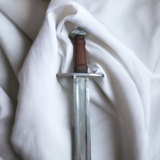This true to original replica has replaced the lobe pommel with the brazil-nut shape and the short, thick guard of earlier has thinned and extended into a characteristic medieval cruciform. This sword is exclusively hand-crafted. The blade is hand-riveted to the pommel. The hilt is leather-strapped.
The blade has a distinctive fuller which offers both great flexibility and a lesser weight. The edges of the blade are not sharpened.
As a Reenactment sword, its designed for Reenactment displays and Medieval Martial Arts.
Steel type: EN45 spring steel
BRAZIL NUT POMMEL' SWORDS: 300 years on the battlefields.
Brazil Nut is a modern term for the characteristic shape of sword pommels.
This huge group of medieval swords was produced widely across Europe from the 10th to the end of the 12th century, and some variants of these pommels we also found even in the late 13th century examples (I define the maximum time frame of the occurrence between the years 930 and 1270). This group includes swords with one-piece pommels, unlike the earlier, mostly complex ones of various types (typologies by Ian Petersen, Alfred Geibig). Brazil nut pommels were very rarely decorated. They were quite often hollow inside and mostly made with iron, less often from a copper alloy.
We know many types and subtypes of these pommels, as they were a very popular form throughout Europe. Ewart Oakeshott classified 6 or 8 types from this group, depending on our interpretation. Similarly, Alfred Geibig distinguishes about 6 to 10 subtypes, depending on our interpretation.




